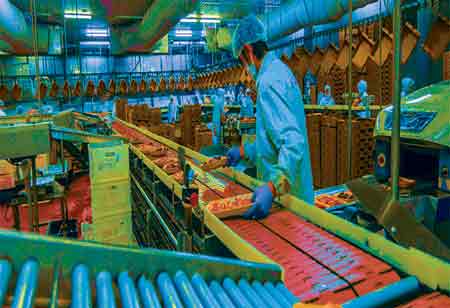THANK YOU FOR SUBSCRIBING
Be first to read the latest tech news, Industry Leader's Insights, and CIO interviews of medium and large enterprises exclusively from Food and Beverage Tech Review
The Impact of Climate Change on Food Safety
Climate change poses food safety risks due to rising temperatures, harmful bacteria growth, agricultural changes, and global supply chain disruptions. Stronger regulations, technological solutions, and a multifaceted approach are needed.

By
Food and Beverages Tech Review | Friday, February 21, 2025
Stay ahead of the industry with exclusive feature stories on the top companies, expert insights and the latest news delivered straight to your inbox. Subscribe today.
Climate change poses food safety risks due to rising temperatures, harmful bacteria growth, agricultural changes, and global supply chain disruptions. Stronger regulations, technological solutions, and a multifaceted approach are needed.
FREMONT, CA: Climate change has become one of the most pressing global challenges. It threatens ecosystems and biodiversity and has severe implications for human health and food security. One area of growing concern is the impact of climate change on food safety. Changes in temperatures, precipitation patterns, and extreme weather events can exacerbate risks related to food contamination, production, and distribution.
How Climate Change Affects Food Safety
The Role of Temperature
Rising global temperatures significantly impact the growth and survival of harmful microorganisms in food. Bacteria such as Salmonella and Listeria thrive in warmer conditions, increasing the prevalence of foodborne illnesses. Additionally, prolonged heat waves accelerate the spoilage of fresh produce, dairy, and seafood, posing new challenges for food storage and transportation systems. Enhanced refrigeration and preservation methods are critical in mitigating these risks.
Changes in Agricultural Practices
Climate change forces farmers to modify their agricultural practices to cope with shifting environmental conditions. Higher temperatures and increased humidity contribute to rising pest populations, prompting greater pesticide use. This raises concerns about chemical residues in food and potential health risks for consumers. Furthermore, extreme weather patterns, including floods and droughts, disrupt crop yields and can alter the nutrient composition of food products. These changes affect food availability and have broader implications for global food security.
Water Contamination
Melting glaciers and rising sea levels result in saline intrusion, compromising freshwater supplies. Contaminated water, often used for irrigation or as drinking water for livestock, increases the likelihood of harmful substances entering the human food chain. Pollutants, heavy metals, and microbial contaminants in water sources further exacerbate food safety risks, highlighting the need for improved water management and purification systems.
The Link Between Extreme Weather and Foodborne Pathogens
Due to climate change, extreme weather events, such as hurricanes, floods, and droughts, are becoming more frequent, facilitating the spread of foodborne pathogens. Floodwaters can carry bacteria and viruses to crops, compromising their safety for consumption. Conversely, drought conditions lead to a higher concentration of harmful contaminants in scarce water sources used for agriculture. These disruptions underscore the necessity of resilient food safety measures to protect public health in an increasingly unpredictable climate.
The Global Supply Chain
Climate change impacts extend beyond local food production to disrupt global supply chains. Extreme weather events can delay the transport of perishable goods, increasing the risk of microbiological hazards. Furthermore, poor storage facilities in regions suffering from heat waves can lead to spoilage and waste.
Food Safety Regulations and Risk Management
As the global food industry faces evolving challenges, governments and organizations must continuously adapt food safety regulations to mitigate emerging risks. Strengthening regulatory frameworks and risk management strategies is essential to ensure public health and food security in an increasingly complex supply chain.
Enhanced monitoring technologies, such as blockchain, are crucial in improving traceability within the food supply chain. These innovations enable real-time tracking to ensure that contaminated products are swiftly identified and removed, reducing the risk of widespread foodborne illnesses.
In addition to technological advancements, stronger regulatory measures are necessary to address climate-driven food safety concerns. A globally coordinated approach to food safety policies can help mitigate risks associated with shifting agricultural patterns, extreme weather events, and emerging pathogens linked to climate change.
Furthermore, innovation in food technology can serve as a proactive measure to safeguard food quality. Advances in refrigeration, packaging, and preservation techniques can help counteract the adverse effects of climate change on food safety, extending shelf life and reducing contamination risks. By integrating these strategies, policymakers and industry stakeholders can enhance food safety standards and resilience in the face of emerging challenges.
Addressing the impact of climate change on food safety requires a multi-faceted approach. It involves reducing greenhouse gas emissions, investing in climate-resilient agricultural systems, and ensuring robust food safety management strategies. Public education about food storage and preparation in changing climates is also essential to minimize risks at a household level.
Climate change is inseparable from food safety concerns. To secure a future where food remains safe and accessible, preventative action must be prioritized at the individual and global levels. Collaboration among scientists, policymakers, industries, and consumers is imperative to tackle this pressing issue and protect the health of future generations.
I agree We use cookies on this website to enhance your user experience. By clicking any link on this page you are giving your consent for us to set cookies. More info


However, if you would like to share the information in this article, you may use the link below:
https://www.fbtechrevieweurope.com/news/the-impact-of-climate-change-on-food-safety-nwid-2017.html





